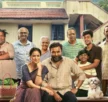Life of Pi – Movie Review
- 21st November 2012
- POST IN :MUSIC
Toronto-based film critic Radheyan Simonpillai reviews Ang Lee’s "Life of Pi" for Thamarai. The film releases on the 21st November 2012.
A great chunk of Life of Pi is set on a lifeboat stranded in the ocean and its testament to director Ang Lee’s prowess that the movie keeps things fascinating during that long haul. The audience won’t get as seasick on that lifeboat as its two inhabitants, a young Tamil boy from Pondecherry and his fierce Tiger.
The boy, Pi (newcomer Suraj Sharma) is emigrating from India to Canada with his family on a Japanese freighter that capsizes during a massive storm. He is the only survivor alongside Richard Parker, a Bengal tiger, immaculately rendered to life by groundbreaking CGI.
Adapting Yann Martel’s bestselling (Obama-approved) novel, David Magee and Ang Lee tackle an epic task. The book is divided into three acts: Pi’s youth as the child of Zookeepers, the adventure at sea here Pi and that hungry tiger circle each other and an epilogue that I won’t discuss to keep the mystery.
To frame these acts, Magee and Lee resort to a narration by an older Pi, played by Irrfan Khan who remains Bollywood’s finest export to Hollywood. Unfortunately, this framing and narration come off as clunky, used as an easy tool to fast track through the meaningful moments in Pi’s life and expand on the broader themes in both the film and the novel.
Despite many dull stretches, an underdeveloped final section and an overall narrative that is rather limp, the film doesn’t sink because Magee and Lee do everything they can to translate the novel’s power. Life of Pi is buoyed by glorious 3D-enhanced visuals and anchored by its meditations on religion and neo-colonialism. The sights are divine (truly) and the movie proceeds to inquire what divinity is.
When we meet Pi, he, like India, is divided between religions. His town is a French colony that has recently been handed back to the locals. Though the film doesn’t make this explicit, you can just imagine the subsequent internal, religious-based tensions that force his family to depart to Canada.
So while Pi is stranded at sea looking for some god (any god) with a tiger on his tail, the movie becomes a broad rumination on the Indian identity and an acute metaphor for the immigrant experience. Pi and that Tiger are rootless, stranded without a land and laying their claim on a lifeboat.
That lifeboat becomes its own little country, abandoned by its colonial ancestry with its occupants left to fight and make peace with each other. Given the film’s Tamil underpinnings, you can’t be blamed for considering Sri Lanka within this context.
If that seems like a lot to chew on for a 3D Hollywood spectacle, don’t worry, Ang Lee gives you a splendid visual feast to go with it. Proceed with the appetite of a starving Tiger.
About the author:
Radheyan Simonpillai—or Rad, as we like to call him—is a Toronto-based film critic with an M.A. in Cinema Studies from the University of Toronto (so he can cite André Bazin, if need be). Rad regularly writes movie reviews for NOW Magazine and AskMen.com and has interviewed movie stars ranging from George Clooney to Kermit the Frog.
You can follow Rad’s work on:
Facebook: http://on.fb.me/Te1ZhU Twitter: https://twitter.com/freshandfrowsy
Photos courtesy of 20th Century Fox Film
- Previous Post
Prathadsan – Meendum Meendum Vendum























